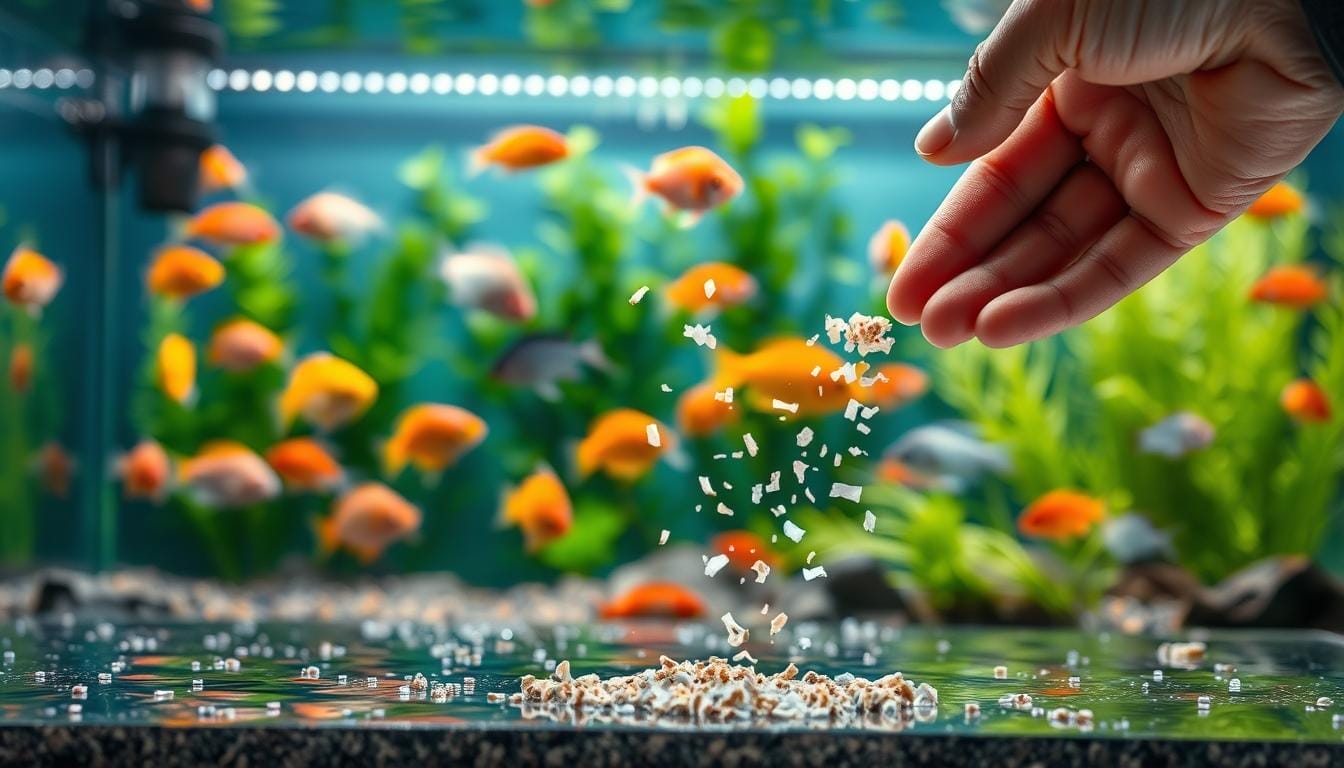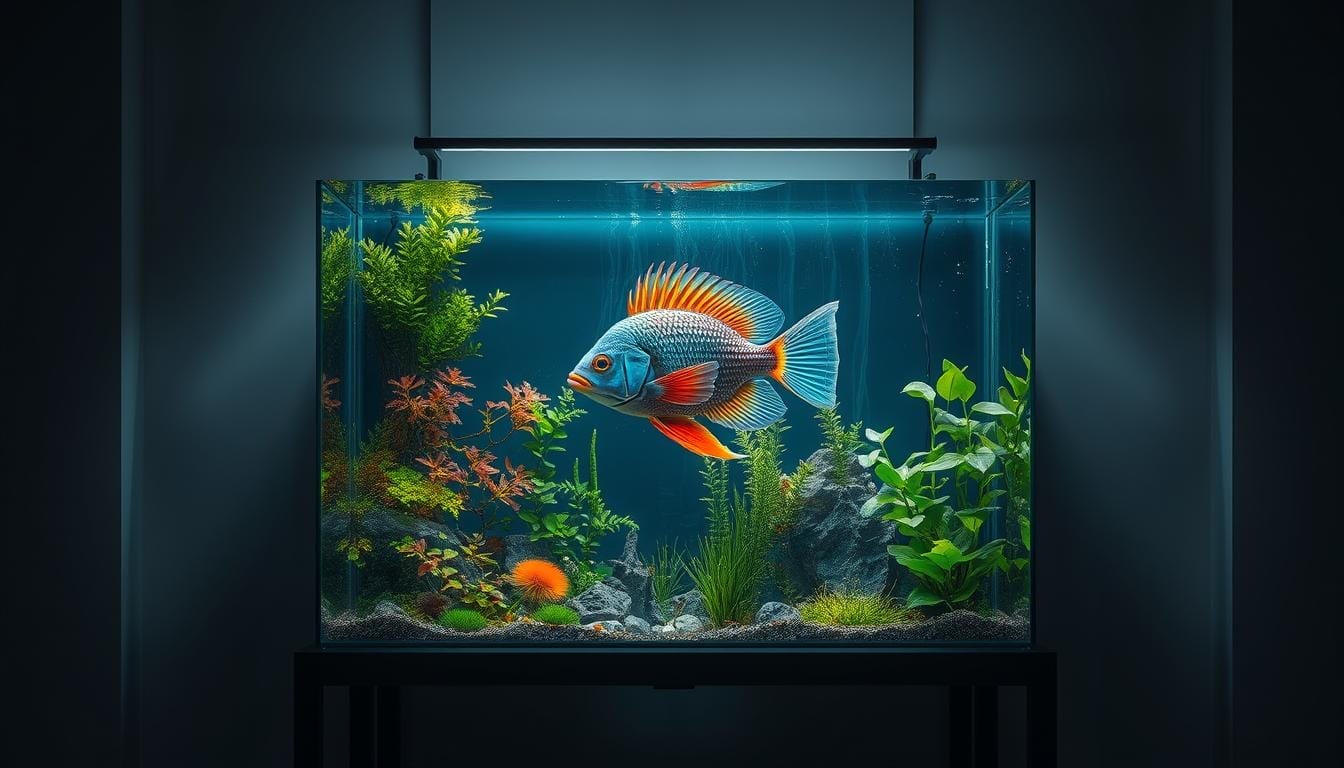
Create a Stunning Aquarium: Centerpiece Fish Ideas Inside

Did you know nano aquariums under 10 gallons have surged in popularity by 300% over the last five years? These compact aquatic worlds let you enjoy underwater beauty without sacrificing space – but there’s one decision that makes or breaks their success.
Your choice of a standout species transforms a simple tank into a living masterpiece. Unlike schooling varieties that blend into groups, these attention-grabbing swimmers become the heart of your aquatic display. Their colors, movements, and behaviors turn routine maintenance into moments of wonder.
Small tanks demand smart planning. A mismatched specimen might outgrow its home or clash with tank mates. That’s why we’ll walk you through selecting creatures that thrive in limited spaces while complementing your aquascape vision. You’ll learn how factors like adult size and temperament impact your entire ecosystem.
This guide helps you avoid common pitfalls while creating a balanced environment. Discover how the right choice elevates your setup from functional to extraordinary – and why starting with this decision saves time, money, and stress down the line.
Setting the Stage for a Vibrant Aquascape
With nano tanks, you don’t need a lot of space to create a captivating aquatic display. These miniature ecosystems bring life to bedrooms, offices, or studio apartments without dominating your decor. Modern innovations make them surprisingly practical – no bulky equipment required.
Why Small-Scale Systems Win Big
New corner filters like Dennerle’s models let you maintain crystal-clear water in tanks as small as 5 gallons. You’ll spend 60% less time on maintenance compared to larger setups thanks to these compact systems. Weekly water changes become quick tasks – just replace a drinking glass worth of liquid instead of hauling buckets.
- Perfect for renters or small homes with limited square footage
- All-in-one kits available at most pet stores simplify setup
- Create intricate landscapes using tiny driftwood pieces and carpeting plants
Beginners love how nano tanks help master water chemistry basics quickly. The smaller volume responds faster to adjustments, letting you see results within hours rather than days. Many hobbyists use these compact setups to test new aquascaping themes before scaling up.
Your tank can serve multiple roles – grow rare moss varieties, house delicate shrimp, or quarantine new arrivals. With smart planning, even a 10-gallon system becomes a self-contained underwater universe that sparks joy daily.
Exploring Diverse Fish Options for Various Tank Setups
Your aquarium becomes a living canvas when you match species to their ideal environments. Let’s examine standout choices that turn functional habitats into breathtaking displays while respecting each tank’s limitations.

10-Gallon Showstoppers With Personality
The Galaxy Koi Betta dazzles with marble-like patterns, thriving solo while ignoring shrimp and snails. For interactive charm, consider a Dwarf Puffer – its curious nature and inflatable defense mechanism create endless fascination.
Celestial Pearl Danios bring cosmic beauty with starry yellow dots. Keep four in a planted 10-gallon for shimmering movement. Ember Tetras offer fiery orange hues, schooling tightly in groups of ten without overcrowding.
Harmonizing 30-Gallon Ecosystems
Soft water tanks housing rasboras and cories gain depth from Blue Emperor Tetras. Their rare purple-blue tones pop against red plants, while gentle fins complement existing swimmers. Maintain stable parameters with apple snails helping clean surfaces.
Flowing Fins Meet Functional Design
Long-tailed species like Bumblebee Platies add drama without chaos. A pair showcases bold yellow stripes while coexisting with ottos. Green Neon Tetras reveal emerald flashes at dawn, creating daily surprises in planted setups.
Expert “centerpiece fish ideas” for a Captivating Aquarium
Transform your aquatic display into living art with strategic species selection. The right focal-point swimmers elevate your tank’s visual impact while maintaining ecosystem harmony. Let’s explore how advanced choices create breathtaking results when paired with smart environmental planning.

Balancing Aesthetics and Tank Conditions
Rocket Clown Killifish bring dynamic energy with their torpedo-shaped bodies and vivid tails. These jumpers demand secure lids but reward careful owners with dazzling displays. Pair them with floating plants to soften light and reduce stress.
Pygmy Sunfish offer rare beauty with iridescent blues and black markings. Their specialized diet of live foods like black worms requires dedication, but their compact size (under 2.5 inches) suits smaller setups. For vibrant purple hues, Purple Moscow Guppies shine as Russian-bred marvels – though sourcing them requires patience and research.
Incorporating Related Elements: Plants, Filters, and Snails
Java moss and anubias enhance colors while providing shelter. Choose low-flow filters to protect delicate fins without compromising water quality. Nerite snails make ideal cleaners but avoid pairing them with aggressive bettas that might nip at their antennae.
Successful combinations balance visual drama with practical needs. Test new additions gradually, monitoring how species interact with plants and tank mates. With thoughtful selection, your underwater world becomes both stunning and sustainable.
Final Reflections on Crafting Your Aquarium Masterpiece
Your tank’s beauty starts with thoughtful choices and grows with care. Matching aquatic life to your setup’s size and conditions creates harmony. Whether choosing bold blues or fiery patterns, each selection reflects your evolving skills.
Consider tank mates carefully – a peaceful snail cleans algae but needs calm companions. Special diets like live worms demand commitment, while breeding pairs require space adjustments. These decisions shape your daily experience and long-term success.
Every change teaches something new. Start small, learn from mistakes, and celebrate progress. Your aquarium becomes a living lesson in balance, sparking conversations about water chemistry or rare species care.
Remember: Great tanks aren’t built overnight. With patience and the knowledge you’ve gained, you’ll create a thriving ecosystem that delights for years. Now’s the time to apply what you’ve learned – your aquatic masterpiece awaits.
FAQ
What species thrive as focal points in small tanks?
For 10-gallon setups, consider dwarf gouramis or a single betta. Their vivid blues and flowing tails create visual interest without overwhelming limited spaces. Pair them with nano companions like neon tetras for contrast.
How do I maintain soft water for delicate species?
Use Indian almond leaves or peat-filtered water to naturally soften conditions. Test weekly with API Freshwater Master Kit, and perform 15% water changes every 7-10 days to stabilize parameters for sensitive fish like cardinal tetras.
Can I mix long-finned varieties with active swimmers?
Yes, but choose tankmates carefully. Pair slower-moving showstoppers like veil-tail guppies with peaceful mid-level swimmers such as harlequin rasboras. Ensure ample plants like Java fern for retreat spaces and monitor fin-nipping behavior.
What plants complement colorful showcase species?
Red-root floaters enhance bettas’ jewel tones, while dwarf hairgrass carpets highlight koi angelfish patterns. Anubias nana provides resting spots for gouramis without overshadowing their colors. Always match lighting to plant needs.
Why add snails to a display tank?
Nerite snails handle algae without breeding excessively, keeping glass clean for optimal visibility. Their striped shells add texture contrast, particularly effective against dark substrates in planted setups.
How often should I upgrade filtration as fish grow?
For species like pearl gouramis that reach 4-5 inches, start with a sponge filter rated for 20 gallons in a 30-gallon tank. Upgrade to a canister filter like Fluval 207 when bioload increases from adult sizes or added tankmates.
Can I keep multiple showcase species together?
A> Limit to one dominant type per tank. For example, pair a single electric blue ram with a school of rummy-nose tetras. Avoid combining territorial types like two male bettas, which can lead to stress and torn fins.





